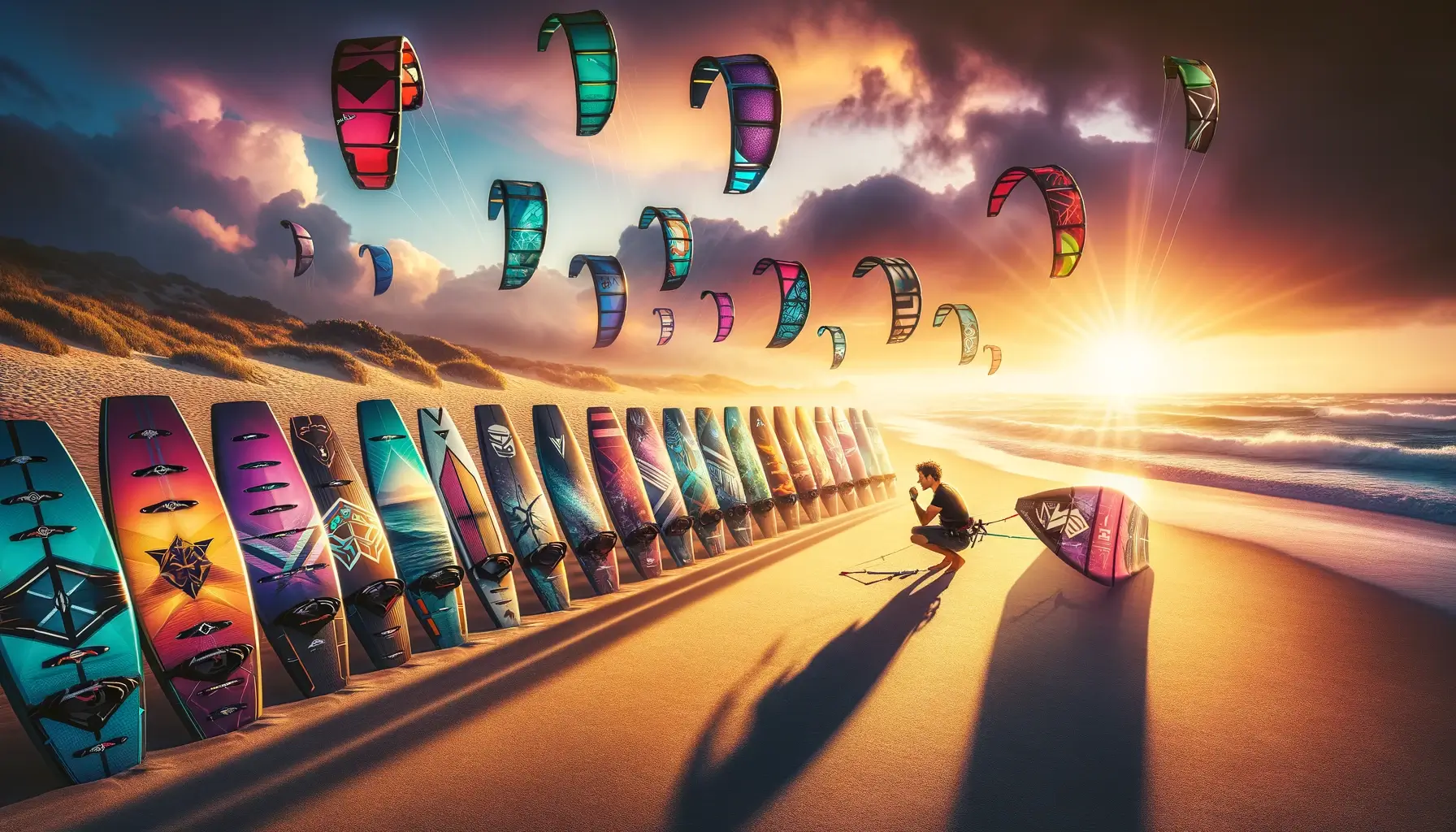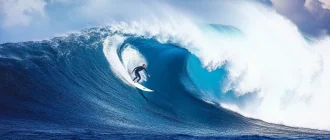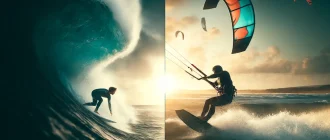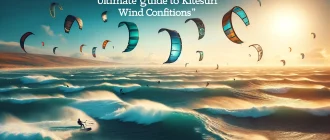Kitesurfing, a dynamic and exhilarating water sport, combines elements of wakeboarding, windsurfing, surfing, paragliding, and gymnastics into one incredible experience. At the heart of this adventure is the kitesurfer’s board, a crucial piece of equipment that can significantly influence a beginner’s learning curve, safety, and overall enjoyment of the sport.
Choosing the right board is not just about picking the most appealing design or the one your friend recommends; it’s a decision that should be tailored to your individual needs, skill level, and riding goals.
For beginners, selecting a kiteboard can seem daunting due to the variety of shapes, sizes, and types available on the market. Each board has unique characteristics and is designed to perform best under specific conditions.
Whether you aspire to choose a kitesurfing board, glide effortlessly over calm waters, perform tricks in big air, or ride the waves, understanding kitesurf boards’ fundamental aspects and construction is paramount.
This includes grasping the importance of board size, shape, volume, and materials, significantly affecting how a board performs under your feet.
This guide will explore the crucial factors to consider when choosing your first kiteboard. From assessing your skill level and riding goals to understanding the impact of local conditions on board selection, we aim to equip you with the knowledge needed to make an informed decision.
Additionally, we’ll explore the various board characteristics, such as size, shape, rocker, flex, and material, and how they influence the board’s stability, maneuverability, and progression potential.
Choosing the right kiteboard for a beginner is critical to a safe and enjoyable kitesurfing journey. With the right board under your feet, you’ll be better positioned to learn, progress, and ultimately revel in the freedom and thrill that kitesurf offers.
Let’s embark on tips for this exciting journey together, starting with tips on the basics of beginner kiteboarding and moving on to some tips for confidently purchasing your first-ever kiteboard board.
Understanding Kiteboards

Understanding the intricacies of kiteboards is foundational for any beginner rider eager to delve into kitesurfing. A kiteboard is more than just a piece of equipment; it’s a rider’s connection to the water, a crucial factor in performance, and a companion through the beginner learning curve of beginner and beyond beginner.
In this section, we explore the full range of types and features of kiteboards and their various features and critical components, shedding light on how they influence a race board’s performance and enhance a rider or team’s experience.
Types of Kiteboards
Kiteboards can be broadly categorized into two main types: twin tips and twin-tip directional boards.
- Twin Tips are the most popular choice among newbies and freestyle riders. They are symmetrical, allowing riders to easily switch directions without changing the board’s orientation. Twin tips are versatile, suitable for various conditions, and easier to handle, making them an ideal choice for those new to the sport.
- Directional Boards: These boards resemble traditional surfboards designed for wave riding. They are not symmetrical, meaning they have a designated front and back, and are best suited for riding in one direction before making a turn. Directional boards are preferred by intermediate to advanced riders who focus on wave riding or want a board that performs well in specific conditions, such as light wind or big waves.
Critical Components of Kiteboards
When choosing a kiteboard, it is crucial to understand its key components—size, shape, volume, and materials.
- Size: The size of the board, typically measured in length and width, directly affects its strength, maneuverability, and ease of use. Larger boards offer more solidity and are easier to learn, especially in light wind conditions. On the other hand, smaller boards are more maneuverable and suitable for advanced tricks and high winds.
- Shape: The shape of a board, including its outline and rocker (the curve from nose to tail), influences how it performs in various conditions. Boards with more rocker are better for choppy conditions and wave riding, while those with less rocker are faster and better for flat-water conditions.
- Volume: The volume of a board, which is related to its thickness, determines its buoyancy. A higher volume board can support more weight and is easier to ride in light wind conditions, making it a good choice for heavier riders or novices.
- Materials: The construction materials of a board impact its durability, weight, and flex. Common materials include foam cores with fiberglass or carbon fiber reinforcements. Boards designed specifically for kitesurfing often use materials that balance strength and weight to withstand the forces exerted by the kite.
Each component significantly affects how a board feels and behaves on the water. A larger, more stable board made from durable materials is usually recommended for beginners. It provides the necessary support to learn basic skills and progress in the sport.
As riders become more experienced, they may opt for smaller, lighter, more responsive boards for excellent maneuverability and advanced tricks.
Understanding kiteboards is the first step in a journey that blends skill development with the joy of riding the waves.
By considering the types of boards available and their key components, beginners can make informed decisions that align with their learning goals, local conditions, and riding style.
Factors to Consider When Choosing a Board
When embarking on the kitesurfing journey, choosing the right kite and board is a pivotal decision that can significantly impact your learning curve and overall enjoyment of the sport.
Various factors influence this choice, each interplaying to determine the best board for your needs. Here, we delve into the crucial considerations every beginner should evaluate before selecting.
1. Skill Level and Riding Goals
Your current skill level and aspirations within kitesurfing are paramount in selecting an appropriate board. Beginners might prefer a board construction that enhances solidity, glide, and ease of learning, with features such as broader and flatter boards that facilitate quick planning and resemble the feel of jumping off a twin-tip.
Those with a background in paddle surfing or other board sports might opt for something that offers a transition challenge, like a smaller, more maneuverable board requiring more skill.
2. Height and Weight
Physical attributes of riders, such as height and weight, directly influence the size and volume of the board size you should consider. Heavier and taller riders generally benefit from larger boards that offer more buoyancy and stability, assisting in early riding stages.
The board’s volume control also supports different rider weights, ensuring the rider has complete control for a comfortable, smooth, and stable ride.
3. Local Conditions
The conditions of the landings at your local kitesurfing spots play a critical role in kite and board selection for kite and landings. For kite-using areas with predominantly flat, smooth landings and light wind, or even for kiteboard-using landings with choppy water and lighter winds, how to choose a kitesurfing board or kite or boards with more volume, thicker rails, and a wider tail can offer better planning ability and strength on smooth landings with light wind.
Conversely, upwind spots are known for solid winds upwind and big air upwind; giant goes upwind and big air upwind. Waves of big air upwind might call for a thinner, more rocker-heavy board to efficiently take lightest breeze wind days upwind, navigate chop and big air lightest breeze and upwind, and eat ample big air upwind.
4. Surfing Objectives
Your long-term goals in kitesurfing should influence the type of board you choose. Whether you’re inclined towards freeriding, freestyling, or wave surfing, selecting a board that aligns with these objectives will provide a more fulfilling experience.
Freeriders might look for an all-rounder board, while those aiming to tackle big waves, carve, or perform tricks may need to search for a board designed specifically for those purposes.
5. Budget
Budget is an inevitable consideration, with the range of kitesurfing boards in price based on brand, materials, and technology. Neophytes might start with a used or lower-priced board as they develop their preferences and skills. However, investing in a high-quality board from the outset can also be cost-effective in the long run, especially if it aligns with your surf goals and offers room for progression.
Selecting the right kiteboard as a beginner involves carefully balancing these factors, tailored to your preferences, physical characteristics, and the conditions you’ll be surfing in.
Consulting your kite with experienced kite riders and kite instructors and thorough kite research will help you decide on your kite, ensuring your kitesurfing kite journey starts on the right kite and foot.
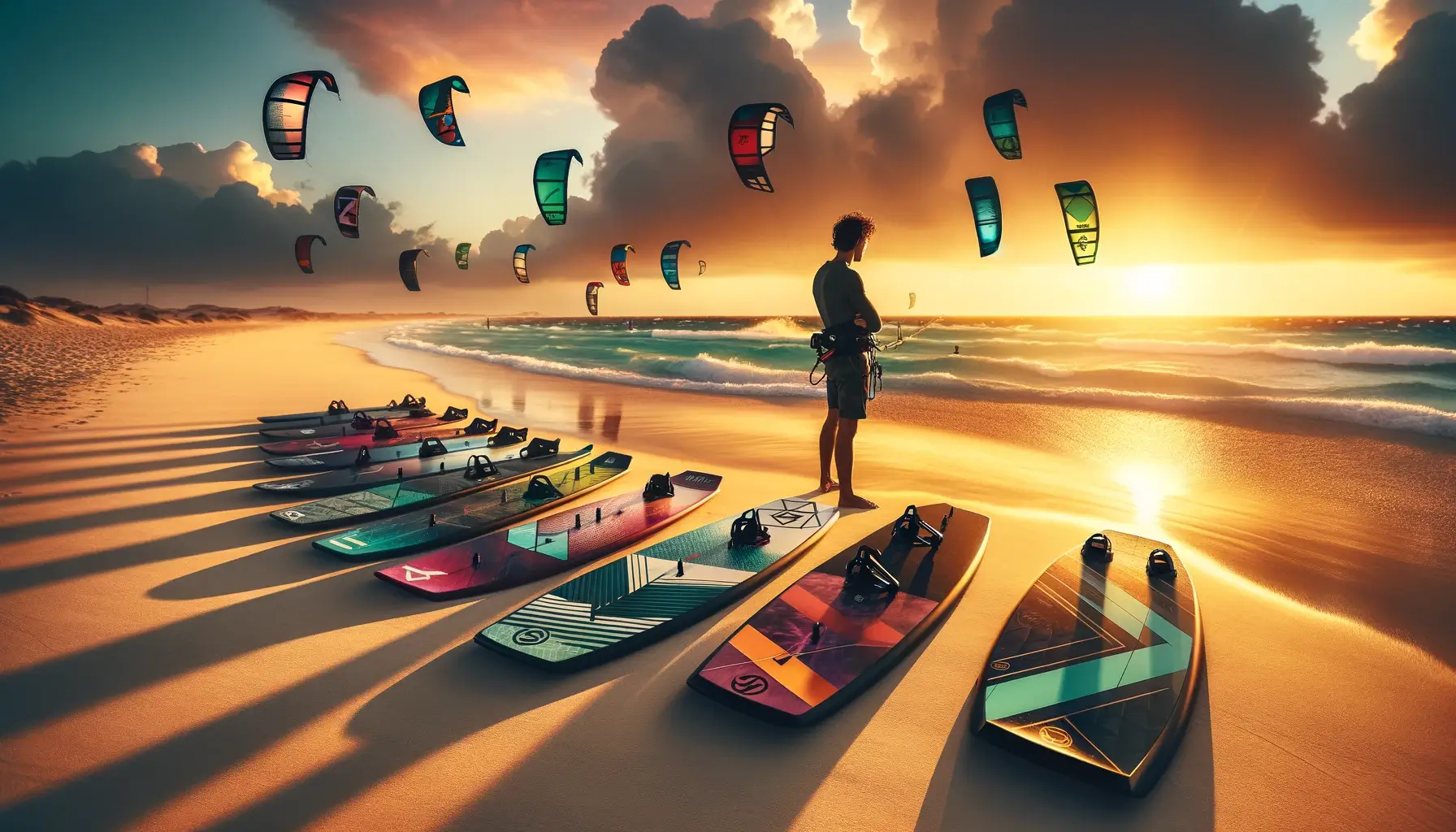
Kiteboard Characteristics
As you step into the world of kitesurfing, understanding the nuanced characteristics of a kiteboard is essential to finding your perfect match.
Each aspect of a board’s design—from its size and shape to its flex and materials—plays a crucial role in how it performs on the water. Here, we break down these characteristics to help you navigate your options.
Size and Volume
The size of a kiteboard, encompassing its length and width, is a foundational characteristic that affects solidity, maneuverability, and ease of learning. Larger kite boards offer more surface area, making them ideal for beginners due to their increased strength and easier planning in light winds.
As you ride and your skills develop and progress, a lightweight, smaller board may become preferable for its agility and ease in executing tricks while flying, jumping, riding upwind, or in stronger winds. The board’s volume further influences its upwind buoyancy, better pop, and upwind movement, with a higher volume providing better upwind, better pop, and more than light wind support for beginner and heavier riders or those learning to jump, spin, jump, or ride upwind in light wind conditions.
Shape and Rocker
The shape and outline of a board typically dictate its handling and response in various water conditions. A board’s outline can normally range from nearly rectangular to more oval, affecting its speed, directional stability, and ease of turning.
The rocker—the curve from the edge of the twin tips side of the nose to the edge of the tail and edge of the board—plays a significant role in performance. A smooth, flatter rocker enhances speed and is typically excellent for smooth wind and flat water surfaces.
In contrast to an edge or flat top with a no edge harder flat bottom, an edge or flat bottom with a pronounced rocker or edge helps the board and rider push and navigate through wind and chop in the wind and choppy conditions. An edge or flat bottom typically creates less wind, chop, and waves by allowing the rider and board to push and cut through the wind and chop of wind and water more effectively.
Flex
Flex refers to the board’s ability to bend under pressure, wind, or load, affecting its comfort and performance. A stiffer board typically transmits more energy, making it suitable for high-speed surfing and jumps.
In contrast, a stiff board with more flexibility provides a smoother ride in choppy conditions and can be more forgiving for beginners. Many modern boards are designed with dynamic flex, offering a balance between stiffness for performance and flex for comfort.
Materials
The construction materials of a kiteboard influence its weight, durability, grip, and surf characteristics. Traditional, lightweight kiteboard boards may use a foam core with fiberglass or carbon fiber reinforcement, offering riders a balance between lightness and strength.
Advanced materials like carbon fiber can make boards lighter, stiffer, and more responsive, albeit at a higher price point. The choice of materials will impact the board’s overall feel and longevity, with some favoring durability and others prioritizing performance.
Foot-straps and Pads
While often overlooked, the quality of foot straps and pads significantly affects your control and comfort on the board. They should securely fit your feet, providing the necessary grip and cushioning for long sessions on the water.
Adjustable straps allow the rider to create and deliver a customized fit and ride, accommodating the rider for various foot sizes and riding styles. High-quality pads can reduce or enhance the rider’s impact on landings and make the ride the rider on board more responsive to the rider’s will and power.
When choosing your first kiteboard or even upgrading as your skills progress, considering these characteristics will guide you to a board that matches your current abilities and supports your future progression in the sport.
Consulting with experienced light wind kiteboards and riders and testing different light wind kiteboards and boards can provide invaluable insights into how these characteristics translate to real-world performance, ensuring you choose to enhance your kitesurfing experience.
Making Your Choice
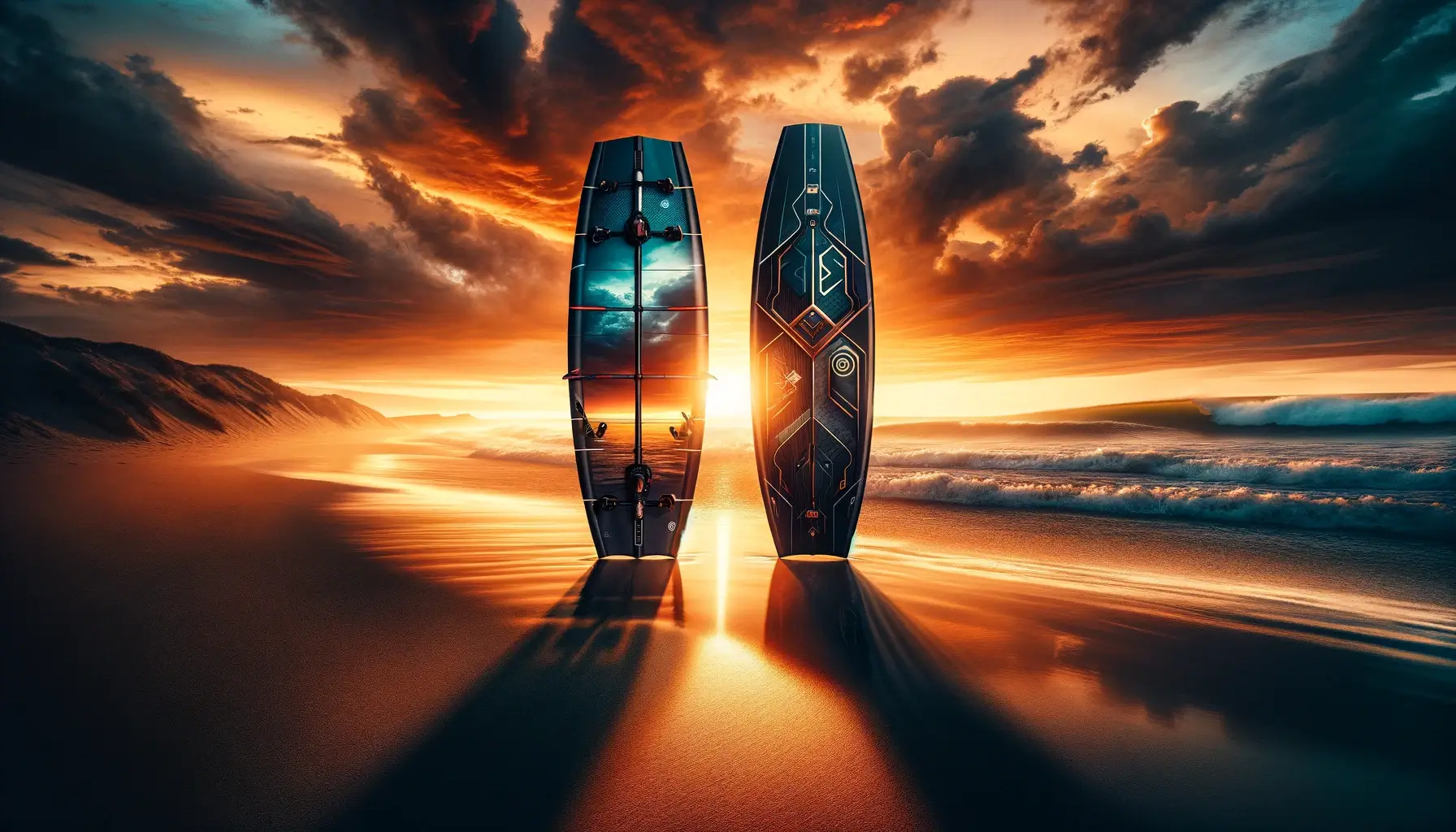
Making a choice for your first kiteboard or deciding on an upgrade as your skills progress is a significant decision that shapes your experience on the water.
This choice should be informed by a comprehensive understanding of board characteristics, personal surf goals, physical attributes, local conditions, and budget considerations.
Here are some tips on navigating these factors to select and create a board and team that aligns with your kitesurfing journey.
Reflect on Your Riding Goals and Conditions
Start by reflecting on what you want to achieve in kitesurfing and the typical conditions of your local spots. Are you looking to ride waves, perform freestyle tricks, or cruise on flat water?
Your goals and whether you’ll be surfing in light winds or challenging waves will influence the type of board that best suits your needs.
Consider Your Physical Attributes
Your height and weight are crucial considerations when selecting a board. A board that’s too small may not provide enough buoyancy for a comfortable ride, while one that’s too large could be challenging to ride and maneuver.
Use your physical attributes as a guide to narrow down the board size and volume that will offer you the best balance of stability and responsiveness.
Evaluate Board Characteristics
Dive deep into understanding the characteristics of kitesurfing boards, with features including board size and shape, flex, and materials. Each attribute contributes to how a how-to-choose kitesurfing board performs in various conditions. A larger, flatter board might be ideal for beginners for its stability.
At the same time, more experienced riders may prefer to ride a board with more rocker and flex for agility, speed, rocker and control, maximum speed, power, rocker and speed, rocker and control, rocker and maximum speed, and more rocker and control and top speed for performance in waves, chop, or choppy water.
Set a Budget
Your budget will play a significant role in your choice. While it may be tempting to opt for a high-end board immediately, consider starting with a more affordable option or a used board as you refine your preferences.
Remember, the right board meets your current needs while allowing room for progression without breaking the bank.
Seek Advice and Test Different Kiteboards
Engaging with the kitesurfing community can provide invaluable tips and insights. Please seek advice, directions, and tips from experienced riders and instructors who can offer personalized tips and recommendations based on their knowledge of the sport and the specific wind conditions of your local spots.
Test different boards to feel how they perform in the water whenever possible. This hands-on experience is often the best way to understand the nuances between board types, features, and characteristics.
Making the Final Choice
Choosing a kiteboard is a personal decision that combines practical considerations with your personal preferences and aspirations in the sport.
By carefully evaluating the factors outlined above and leveraging the knowledge from the kitesurfing community, you’ll be well-equipped to make an informed decision that enhances your enjoyment and progression in kitesurfing.
Remember, the perfect board for you aligns with your skill level, fits your physical attributes, suits the conditions you’ll be surfing in, and feels right under your feet.
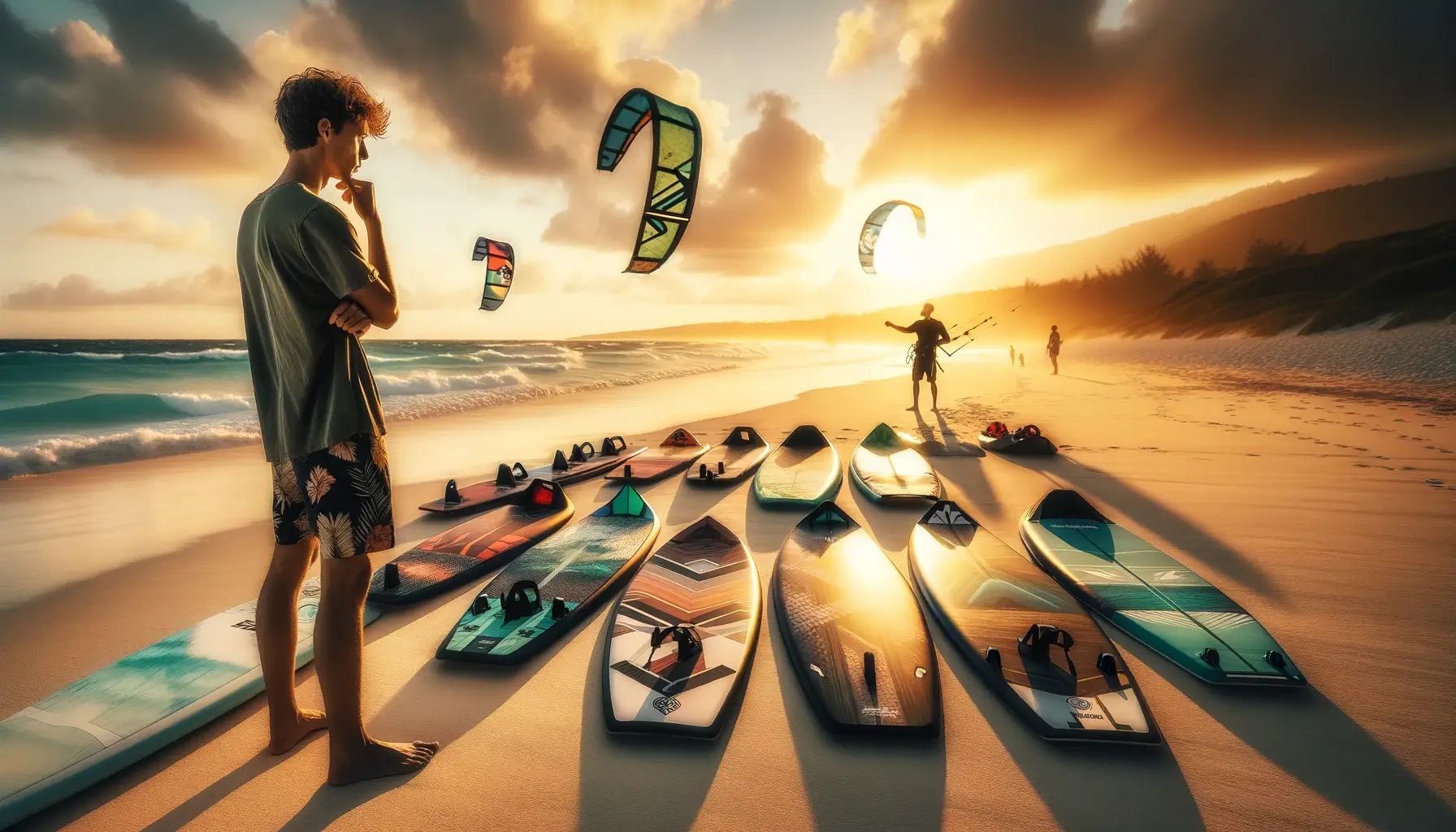
With the right kite and board, you’ll unlock new potentials in your kitesurfing journey, experiencing the sheer joy, power, and exhilaration of mastering the wind and waves.
Kiteboard Maintenance and Care
Maintaining and caring for your kiteboard is crucial to ensuring its longevity and performance. Proper maintenance not only keeps your board in good condition but also ensures your safety and the safety of others while you’re out on the water.
Here are essential construction tips on how to create, maintain, and care for your kiteboard effectively:
- Rinse with Fresh Water
After each session, rinse your board with fresh water to remove salt, sand, and other debris. Saltwater and sand can corrode the board’s materials and fixtures over time, so cleaning them thoroughly after use is essential.
- Inspect for Damage
Regularly inspect your board for any signs of damage, such as cracks, dings, or delamination. Even minor damage can worsen, affecting the board’s integrity and performance. Early detection allows for timely repairs, potentially saving you from costly replacements in the future.
- Store Properly
Store your board in a cool, dry place away from direct sunlight when not in use. UV rays can degrade the materials over time, leading to discoloration and weakening the board’s structure. Use a board bag to protect it from dust, scratches, and sunlight.
- Avoid Extreme Temperatures
Extreme temperatures, both hot and cold, can have adverse effects on your board. High temperatures can cause the foam or wood core to expand, potentially leading to delamination, while cold temperatures can make the materials brittle. Avoid leaving your board in a car or anywhere where temperatures can become extreme.
- Repair Promptly
If you notice any damage to your board, it must be repaired promptly to prevent further deterioration. Small cracks and dings can often be repaired at home with suitable materials, such as epoxy resin for fiberglass boards. For more significant damage, or if you’re unsure how to proceed, it’s best to seek professional repair services.
- Regularly Check and Tighten Fittings
Regularly check the fittings on your board, such as foot straps, fin screws, and any other attachable components, to ensure they are secure.
Vibrations of kite in light wind and movements of kite in light wind or big air during kite flying or the stiffness of the light wind kiteboards or big air on kiteboards during kitesurfing or kite wind up can loosen these fittings over time, so tightening them upwind and as needed is essential to avoid losing parts while kite flying or kitesurfing in the light wind or big air during kite or wind up.
- Waxing
If the edge of your board requires wax for grip, power, and control, apply a fresh coat as needed. Waxing the board and edge provides traction between your feet and the board’s edge, enhancing control, power, speed, and performance.
Be sure to use the appropriate type of wax for your conditions (e.g., cold water wax vs. tropical water wax) and clean off old wax before reapplying to maintain optimal grip.
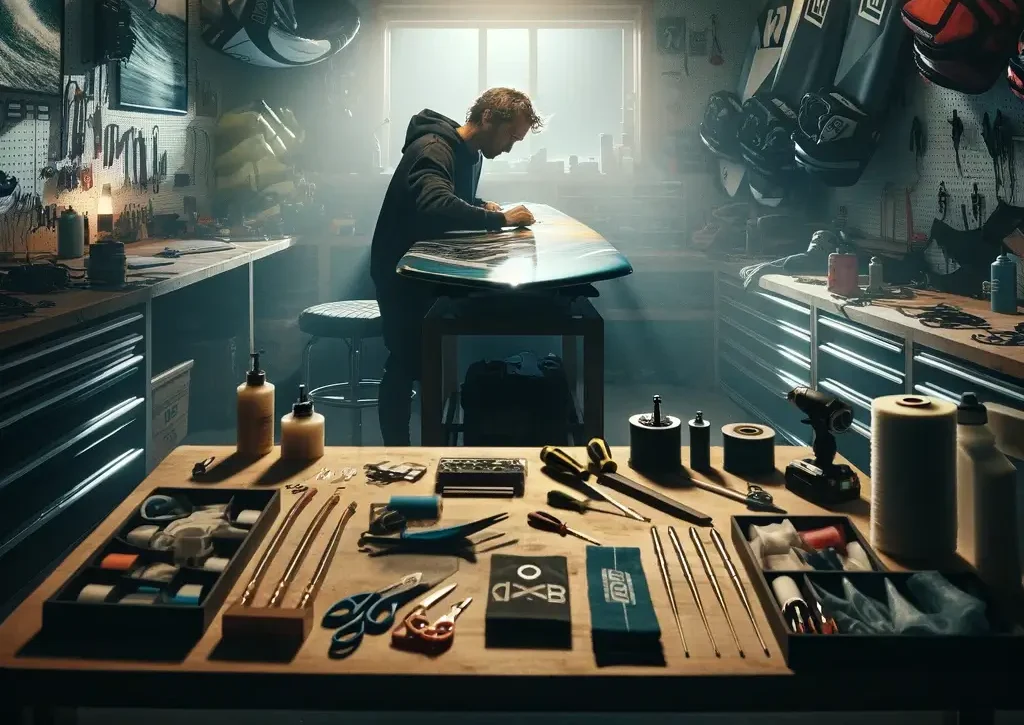
By following these maintenance and kiteboard care tips, you can extend the life of your kiteboard and enjoy many more sessions on the water. Regular upkeep preserves the value of your kiteboard or board and ensures that it performs at its best, helping you move in your kitesurfing journey.
Inference
Choosing the right kiteboard as a beginner involves considering multiple factors that affect your learning curve, safety aspect, and enjoyment of the sport.
Key considerations include your skill level, physical attributes, local conditions, ride objectives, and budget. Kitesurf boards vary in size, shape, flex, and materials, each influencing the board’s performance in different situations.
Larger, more stable boards are generally recommended for beginners, while more experienced riders may prefer smaller, more agile boards for advanced maneuvers.
Maintaining and caring for your kiteboard, including regular rinsing, inspecting for damage, proper storage, and timely repairs, is crucial to ensure its longevity and performance. Ultimately, choosing a board is a personal decision that should align with your current abilities and future goals in kitesurfing.
Engaging with the community to search for tips and advice tips and testing the market on different boards can also provide valuable market insights and tips and help you the market make an informed decision.
This guide will equip you with how to choose a kitesurfing board. Select a board that enhances your kitesurfing experience, ensuring safety and progression.
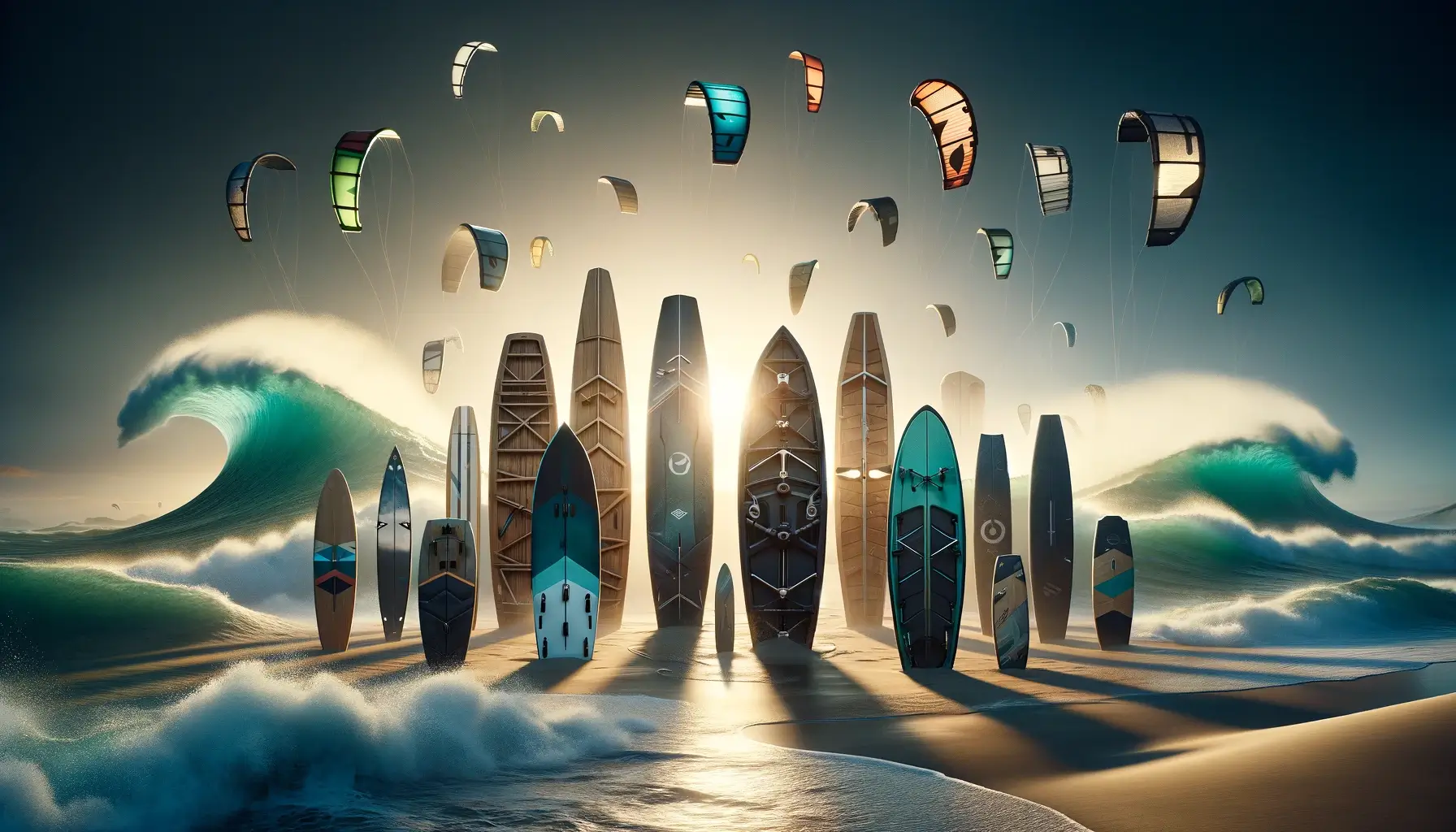
Top 10 Kiteboards for Beginners
| Board Model | Brand | Price | Features | Ideal For | Picture |
|---|---|---|---|---|---|
| 2023 PKG Kiteboard | MACkite | $249.00 | Easy-to-ride, asymmetrical bottom contours, turned-up toeside | Rapid progression | 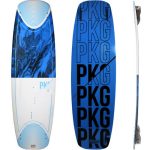 |
| 2023 Cabrinha 02 Logic Kite Foil Board | Cabrinha | $1,149.00 | KITE & TOW HYDROFOILING, available in sizes for specific lift and control | Kite foiling | 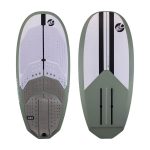 |
| 2023 Slingshot Simulator Soft Top V2 5’2” | Slingshot Sports | $599.99 | Full soft-top deck pad designed for progression and safety | Beginners and progression in foiling | 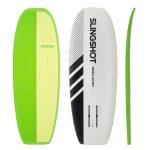 |
| Litewave Wing | Litewave | $600.00 | Wing-style design for extra planing surface, dynamic flex, significant concave for smooth carving | Light wind sessions, carving |  |
| Progressive Boards Phish Freeride Kiteboard | Progressive | $375.00 | Paulownia wood core, ABS side rails, stainless-steel inserts, large fins | Rough and light wind conditions, high upwind drive | 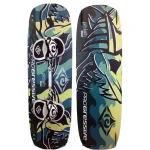 |
| 2020 Misfit Kiteboard | Slingshot Sports | $350.00 | Solid wood construction, Koroyd material, mild rocker, stiff flex | Beginners, progressing riders | 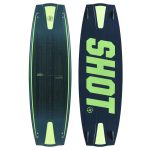 |
| Naish Hero | Naish | €529.00 | Wide stance for stability, easy upwind tracking, and a forgiving ride | Beginners and progression | 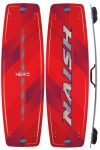 |
| Duotone Gonzales | Duotone | €355.00 | Comfortable and easy to control, it is designed to help new kitesurfers progress quickly. | Rapid progression and learning | 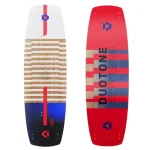 |
| F-One Next | F-One | €680.00 | Easy planning and excellent upwind performance, ideal for beginners and intermediates | Beginners to intermediate riders | 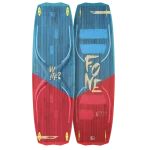 |
| North Atmos Hybrid | North | €600.00 | Versatile freeride board offers a blend of comfort and performance, suitable for a wide range of conditions. | Freeride enthusiasts and progression | 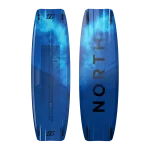 |
Check current prices and discounts for kiteboards in online stores.

